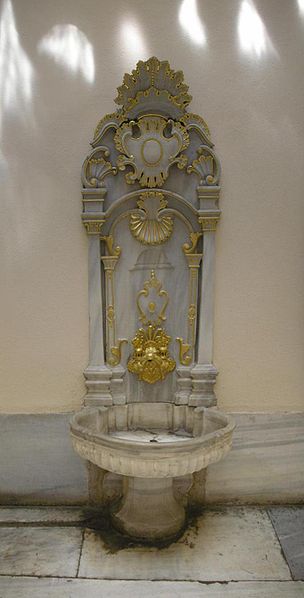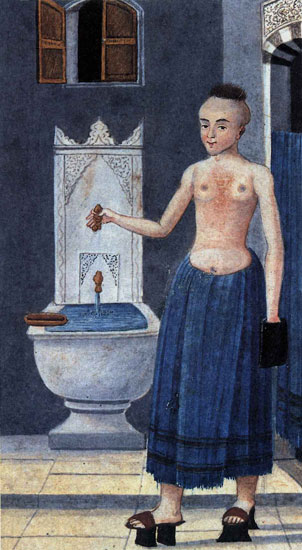
A Turkish bath (Turkish: Hamam) is the Turkish variant of a steam bath, sauna or Russian Bath, distinguished by a focus on water, as distinct from ambient steam.
In Western Europe, the 'Turkish bath' as a method of cleansing and relaxation became popular during the Victorian era. The process involved in taking a Turkish bath is similar to that of a sauna, but is more closely related to ancient Greek and ancient Roman bathing practices.
A person taking a Turkish bath first relaxes in a room (known as the warm room) that is heated by a continuous flow of hot, dry air allowing the bather to perspire freely. Bathers may then move to an even hotter room (known as the hot room) before splashing themselves with cold water. After performing a full body wash and receiving a massage, bathers finally retire to the cooling-room for a period of relaxation.
Architecture
The hamam combines the functionality and the structural elements of its predecessors in Anatolia, the Roman thermae and Eastern Roman baths, with the central Asian Turkish tradition of steam bathing, ritual cleansing and respect of water. It is also known that Arabs built versions of the Greek-Roman baths that they encountered following their conquest of Alexandria in Egypt. However, the Turkish bath has improved style and functionality that emerged as annex buildings of mosques or as re-use of the Eastern Roman baths.
After the Ottomans took over the Eastern Roman Empire their Hammams were originally structures annexed to mosques. However they quickly evolved into institutions unto themselves and eventually, with the works of the Ottoman architect Sinan, into monumental structural complexes, the finest example being the "Çemberlitaş Hamamı" in Istanbul, built in 1584.
Like its Roman predecessor a typical hammam consists of three basic, interconnected rooms: the sıcaklık (or hararet -caldarium), which is the hot room; the warm room (tepidarium), which is the intermediate room; and the soğukluk, which is the cool room (frigidarium).
The sıcaklık usually has a large dome decorated with small glass windows that create a half-light; it also contains a large marble stone called göbek taşı (tummy stone) at the center that the customers lie on, and niches with fountains in the corners. This room is for soaking up steam and getting scrub massages. The warm room is used for washing up with soap and water and the soğukluk is to relax, dress up, have a refreshing drink, sometimes tea, and, where available, a nap in a private cubicle after the massage. A few of the hamams in Istanbul also contain mikvehs, ritual-cleansing baths for Jewish women.
The hamam, like its precursors, is not exclusive to men. Hamam complexes usually contain separate quarters for men and women; or males and females are admitted at separate times. Because they were social centers as well as baths hamams became numerous during the time of the Ottoman Empire and were built in almost every Ottoman city. On many occasions they became places of entertainment (e.g. dancing and food, especially in the women's quarters) and ceremonies, such as before weddings, high-holidays, celebrating newborns, beauty trips.
Several accessories from Roman times survive in modern hamams, such as the peştemal (a special cloth of silk and/or cotton to cover the body, like a pareo), nalın (wooden clogs that prevent slipping on the wet floor, or mother-of-pearl), kese (a rough mitt for massage), and sometimes jewel boxes, gilded soap boxes, mirrors, henna bowls, and perfume bottles.
Tellak (Staff)

Traditionally, the masseurs in the baths, tellak in Turkish, were young men who helped wash clients by soaping and scrubbing their bodies. They were recruited from among the ranks of the non-Muslim of the Turkish empire as such work was seen as below the dignity of a Muslim.
After the defeat and dismemberment of the Ottoman army in the early 20th century, the role of tellak boys was filled by adult attendants[2] that scrub and give massages.
Source: wikipedia